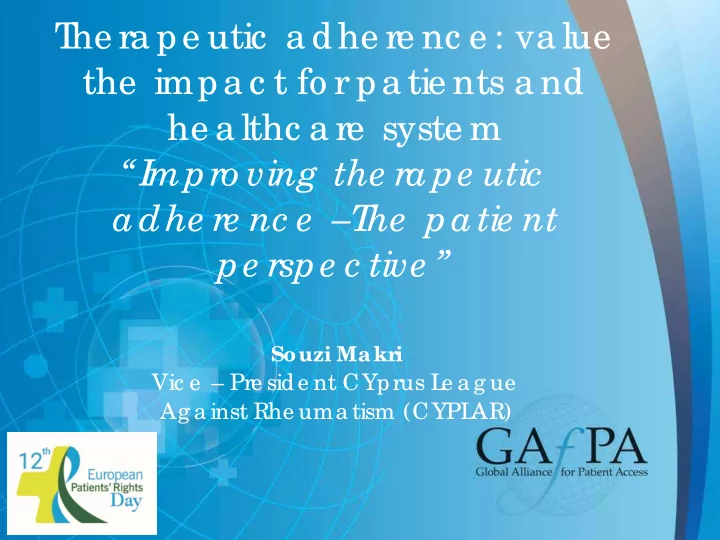

T he ra pe utic a dhe re nc e : va lue the impa c t fo r pa tie nts a nd he a lthc a re syste m “I mpro ving the rape utic adhe re nc e –T he patie nt pe rspe c tive ” Souzi Makr i Vic e – Pre side nt CYprus L e a g ue Ag a inst Rhe uma tism (CYPL AR)
GAfPA Introduction The Global Alliance for Patient Access (GAfPA) is a network of physicians and patient advocates with the shared mission of promoting health policy that ensures patient access to appropriate clinical care and approved therapies. GAfPA accomplishes this mission through educating physicians and patients on health policy issues and developing education material and advocacy initiatives to promote informed policymaking.
GAfPA’s Focus • International network of physicians advocates for patient access to approved therapies and appropriate clinical care • Policy-focused advocacy with non-profit partners Patient Groups • Medical Societies • • Provide issue briefings, develop educational materials, and support advocacy initiatives • Biologics, Pain, Cancer, Inflammation, Respiratory, and Infant Health
Therapeutic adherence: Definition & Common Features • Definition by the World Health Organization: “The degree to which the person’s behavior corresponds with the agreed recommendations from a health care provider.”¹ • The effectiveness of a treatment depends on¹: Efficacy of a medication • Patient adherence • • Important for the improvement of therapeutic adherence is the active involvement and cooperation among patients’ organizations, health care professionals and health care systems¹ Source:1 Beena J., Jimmy J. (2011) Patient Medication Adherence: Measures in Daily Practice 26(3): 155–159 https:/ / www.ncbi.nlm.nih.gov/ pmc/ articles/ PMC3191684/
Therapeutic adherence: Barriers Main barriers for the achievement of an effective therapeutic adherence: • Poor health provider-patient communication¹ • Lack of access to information • Lack of patient education (inadequate knowledge and about the therapy) • Policy issues (lack of effective cooperation among patients’ organizations and policy makers) • Economic • Equity • Cultural Source:1 Beena J., Jimmy J. (2011) Patient Medication Adherence: Measures in Daily Practice 26(3): 155–159 https:/ / www.ncbi.nlm.nih.gov/ pmc/ articles/ PMC3191684/
Therapeutic adherence: Improvement of therapeutic adherence A multi-stakeholder dialogue and approach is needed to be carried out and established with the support and cooperation of all the parties involved in therapeutic process: • Patients’ Organizations • Health professionals • Policy makers
Cooperation among Stakeholders Patients’ Organizations & Policy Makers Why is it important? Ensure that patients’ voices and needs are listened and taken • into account in the development of policies Enable the policy maker to have a clear view and overall • perspective on the real-life experiences of diseases and their management Facilitate patients’ organizations understanding of the • competences and role of the policy maker Contribute to more efficient and targeted communication thus • improving awareness of obstacles and problems faced by patients Cooperation must be based on fundamental principles like • transparency, independence and integrity, accountability, appropriate interaction, effective communication and continuous improvement
Example of Cooperation: Patients’ Organizations & Policy Makers
Cooperation among Stakeholders Patients’ Organizations & Health Care Professionals Why is it important? Patients aspect: Take better care of themselves, have • better understanding of their condition and treatments and monitor their health by themselves Physicians aspect: Improve their diagnosis and treatment • suggestions while treatment and therapeutic adherence are more effective due to increased patient involvement The more doctors and patients work together, the more • patients will feel that they are a part of their care Patients have their areas of expertise too – they know • themselves and what is wrong with them
Example of Cooperation among Patients’ Organizations What: Two-days workshop organized by AGORA in cooperation with GAfPA (Budapest, 13-14 January 2017) Content: Two trending subjects related to RMDs: Biologic and Biosimilar medication and treatments for RMDs • The use of self-management programs for RMDs • Aims: Increase the understanding of the various biologic and • biosimilar medicines in Europe. Equip patients with effective tools to inform policymakers • about patient concerns. Examine the role of self-management programs in • supporting patients with RMDs
Conclusions • Patients’ education and access to information are key elements for the improvement and effectiveness of the therapeutic adherence • Patients’ empowerment to become partners in the policy and treatment decision-making process are essentials for achieving the best results in terms of patients’ therapeutic adherence
Questions?
T he ra pe utic a dhe re nc e : va lue the impa c t fo r pa tie nts a nd he a lthc a re syste m “I mpro ving the rape utic adhe re nc e –T he patie nt pe rspe c tive ” Souzi Makr i Vic e – Pre side nt CYprus L e a g ue Ag a inst Rhe uma tism (CYPL AR)
Recommend
More recommend